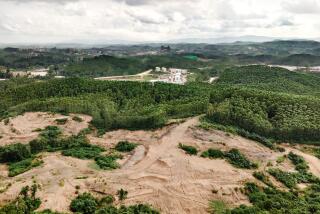City Attempts Balancing Act on Its Heritage
LUANG PRABANG, Laos — Nearly 100 years ago, the wife of a French colonial doctor wondered whether this ancient royal seat could stay immune to the spread of crass commercialism.
“Will Luang Prabang be in our century of exact sciences, of quick profits, of victory by money, the refuge of the last dreamers, the last lovers, the last troubadours?” Marthe Bassene wrote in 1909.
Walking along the city’s streets past shaggy backpackers, pizza parlors and rows of guesthouses, past Buddhist monks besieged by tourists armed with video cameras, many are led to answer a disheartening “No.”
Luang Prabang’s unique atmosphere and urbanscape had long been buffered by its remote location -- a stunning Mekong River valley deep in the hinterlands -- as well as decades of war and Laos’ self-imposed isolation. That ended when the bankrupt communist government threw open the country’s doors to tourism in the early 1990s.
UNESCO accelerated traffic to Luang Prabang by declaring the onetime royal capital a World Heritage Site in 1995, describing it as “the best preserved city of Southeast Asia” -- a magic fusion of traditional Lao dwellings, French colonial architecture and more than 30 graceful monasteries, some dating back to the city’s origins in the 14th century.
The U.N. agency’s involvement, plus government legislation, appear to have saved Luang Prabang from the fate of many historic Asian gems razed by bulldozers or degraded by high-rises and other alien architecture.
UNESCO inventoried every building in town, put 642 sites on a protected list and laid down strict regulations, to become Lao law this year, on how old buildings could be renovated and new construction styled.
The master plan covers more than the historic core, which is set on a narrow peninsula between the Mekong and Kham rivers. It also includes Luang Prabang’s newer urbanized zones and the surrounding landscape, and it protects 183 ponds that serve both environmental and aesthetic functions.
Sustained by some $50 million in aid from UNESCO, France and the European Union, the effort has been hailed, but also criticized.
“This is not just a place of beautiful architecture, but one of a special culture, atmosphere, way of life. This is still a living place,” said Francis Engelmann, a former UNESCO consultant. “But maybe one day you will be visiting Disneyland.”
The boom is well on its way. Some 100,000 foreign visitors now find their way here each year by land, air and river, filling up more than 100 hotels and guesthouses. They put increasing pressure on the city’s scant resources and fragile charm, especially within the 62-acre historic heart, which is home to 25,000 people.
Pierre Guedant, an expert at UNESCO-supported Heritage House, says traditional life is vanishing and the community dissolving as everyone from back-alley vendors to teachers and doctors scrambles to get into the more profitable tourist trade.
As rents increase, native homeowners are moving out and away, collecting checks from foreigners, especially the French, who have flocked in to start chic restaurants, shops and entertainment spots. Performed now for the benefit of visitors, centuries-old ceremonies and rituals are losing their meaning.
“The town is basically being preserved for the sake of the tourist,” said Joanne Smith, a former London fashion photographer who opened a boutique selling Lao fabrics four years ago.
But even those who lament Luang Prabang’s lost serenity acknowledge that tourism benefits a region of Laos where annual incomes average $200 a person, giving hope for a better future.
Attitudes of residents vary. The older generation longs for the good old days. Many are proud of the city’s World Heritage status. Others are happy to profit from it but chafe under the building restrictions.
Many people don’t like the feeling of being stuck in the past, Engelmann says. “They want to be modern at any price. When we talk to them about preservation, they think that this is something dirty, old, in their grandfather’s style.”
As in other Asian countries, some people like to build “architectural monsters aping half-California, half-Swiss, half-French Basque styles,” he said. Wood, the traditional building material, is shunned in favor of less expensive and longer-lasting concrete and corrugated iron.
Sewage and pollution mount as more hotels are built and roads broadened. Tourist buses are breaking a ban on vehicles entering the historic center with more than 12 passengers. There is talk of spanning the Mekong with a bridge.
But Guedant sees a greater, and more intangible, problem.
“The town will be turned into a museum,” the consultant said. “It is something UNESCO wanted to avoid from the start, but it is very difficult to stop now.”
More to Read
Sign up for Essential California
The most important California stories and recommendations in your inbox every morning.
You may occasionally receive promotional content from the Los Angeles Times.









